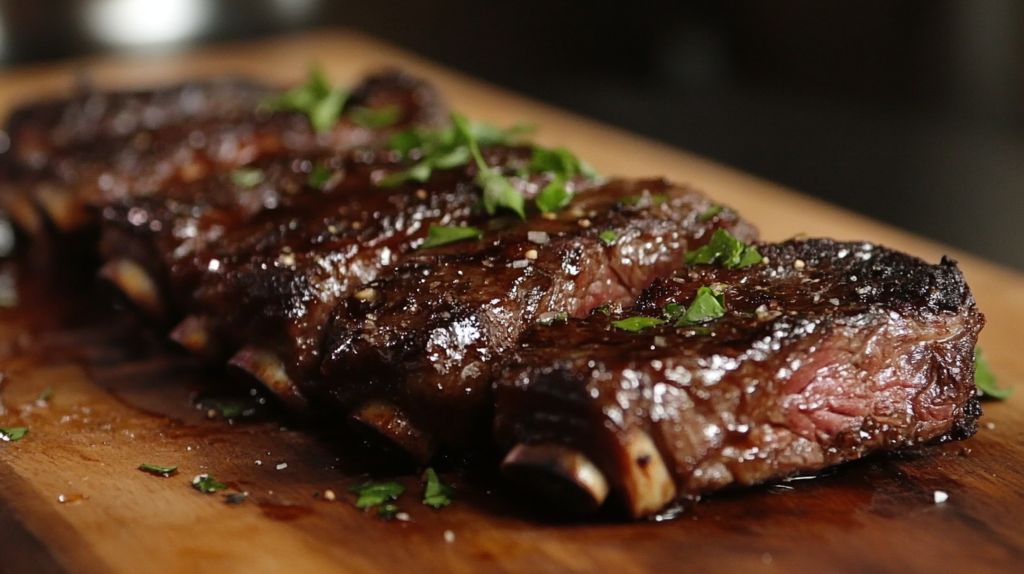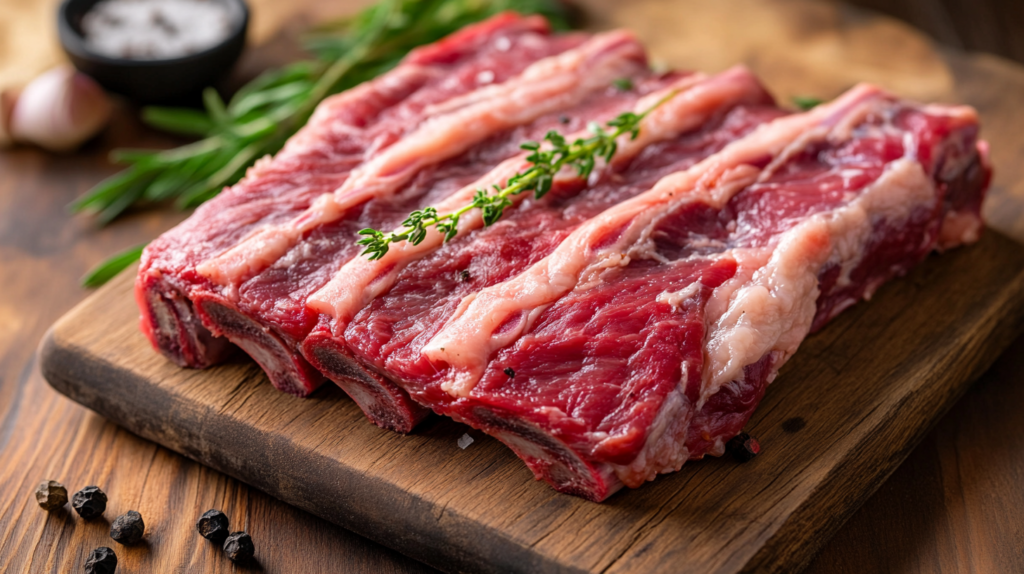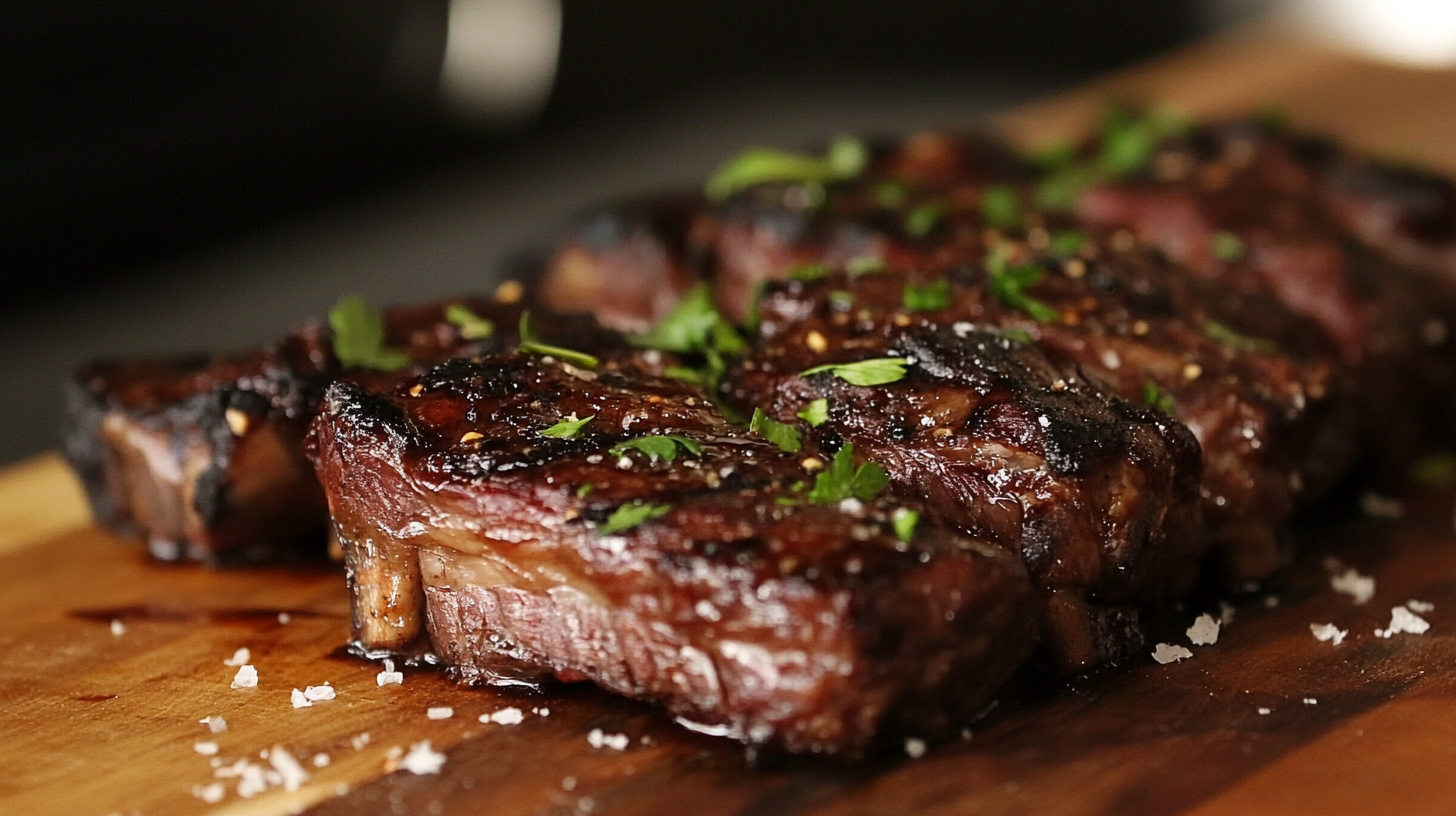Boneless beef ribs are an incredibly versatile and delicious option for those who want a tender, juicy cut of meat without the bone. Whether you’re cooking for a family dinner or hosting a barbecue with friends, boneless beef ribs make an excellent choice. Their rich, beefy flavor, combined with their ability to absorb marinades and seasonings, ensures that every bite is a flavorful delight.
What’s great about boneless beef ribs is their versatility. You can cook them using a variety of methods, from grilling and roasting to slow cooking. In this guide, we’ll walk you through everything you need to know to prepare boneless beef ribs that are tender, juicy, and full of flavor. Let’s dive in!
Why Boneless Beef Ribs Are a Great Choice for Any Meal
Boneless beef ribs are a cut that offers both simplicity and flavor. Unlike bone-in ribs, which can be harder to manage when cooking or eating, boneless beef ribs are much easier to handle while still delivering the same rich, meaty experience.
Here’s why boneless beef ribs should be on your cooking radar:
- Tender and Flavorful: Boneless beef ribs are cut from the rib section of the cow, offering deep, beefy flavor that’s perfect for grilling, roasting, or slow-cooking. Since the meat is marbled with fat, it remains tender and juicy when cooked properly.
- Quick and Easy to Cook: Without the bone, boneless beef ribs cook faster than traditional bone-in ribs. This makes them ideal for weeknight meals or when you’re short on time but still want a comforting dish.
- Versatile Cooking Methods: Boneless beef ribs can be cooked using a variety of methods, from grilling and pan-searing to slow-roasting or braising. This gives you the freedom to choose the cooking style that best fits your preference and available time.
- Great for Meal Prep: Whether you’re planning a big family dinner or a week’s worth of meals, boneless beef ribs are perfect for meal prep. They store well in the refrigerator and can be reheated without losing flavor or texture.
“Boneless beef ribs offer the perfect balance of convenience and flavor, making them a great choice for both quick meals and special occasions!” 🍖👨🍳
What Makes Boneless Beef Ribs Different from Regular Beef Ribs?
While boneless beef ribs and traditional beef ribs might seem similar at first glance, there are key differences that set them apart.
- Bone-In vs. Boneless: Traditional beef ribs include the bone, which adds a slightly smoky flavor when grilled or roasted. Boneless beef ribs, on the other hand, are just the meat—no bone to worry about. This makes boneless beef ribs easier to slice and serve.
- Cooking Time: Bone-in ribs typically require a longer cooking time, especially when slow-cooked, due to the bone acting as an insulator. Boneless beef ribs cook more quickly, making them ideal for faster meal preparation.
- Texture: Because they are boneless, the texture of boneless beef ribs is slightly different. The meat is more uniform and tender, as there’s no bone to separate the muscle fibers. This gives boneless beef ribs a smoother texture, especially when braised or grilled.
“The key difference between boneless beef ribs and regular beef ribs is the absence of the bone, which makes for quicker cooking and easier handling!” 🔪🍽️

Essential Ingredients for Making Boneless Beef Ribs
To make the perfect boneless beef ribs, you don’t need a long list of ingredients—just a few essential items to bring out the beefy goodness. Here’s what you’ll need:
Choosing the Right Cut of Boneless Beef Ribs
When buying boneless beef ribs, it’s important to choose the right cut to ensure you get the best flavor and tenderness. Here’s what to look for:
- Quality of Meat: Choose well-marbled boneless beef ribs, as the fat adds flavor and moisture. The best cuts will have small streaks of fat running through the meat, which will melt and keep the meat juicy as it cooks.
- Thickness of the Ribs: Boneless beef ribs can vary in thickness, so it’s important to select a cut that fits your desired cooking time. Thicker cuts will take longer to cook, while thinner ones will cook more quickly.
- Freshness: Always check the freshness of the meat when purchasing. Look for bright red color and a firm texture. Avoid ribs with discoloration or an off smell.
“The right cut of boneless beef ribs is the key to achieving tenderness and flavor—look for well-marbled meat and fresh cuts!” 🛒🍖
Seasoning and Marinades: Bringing Out the Best Flavor
While boneless beef ribs are flavorful on their own, a good seasoning or marinade can take them to the next level. Here’s how to bring out the best flavor in your ribs:
- Dry Rubs: For a simple, flavorful seasoning, use a dry rub made from spices like garlic powder, onion powder, paprika, black pepper, and salt. Rub the seasoning generously over the ribs and let it sit for at least 30 minutes (or overnight) to let the flavors penetrate the meat.
- Marinades: If you prefer a more intense flavor, marinate the boneless beef ribs for a few hours or overnight. A marinade made from soy sauce, balsamic vinegar, brown sugar, and garlic will add depth and sweetness to the ribs.
- Salt and Pepper: If you’re in a hurry, salt and pepper alone can be enough to enhance the beef flavor. Just be sure to season the ribs well before cooking.
“Seasoning and marinating your boneless beef ribs brings out the rich, meaty flavor—experiment with different spices for a custom taste!” 🌿🧂
Tools and Equipment You’ll Need for the Perfect Ribs
Having the right tools can make the cooking process easier and more efficient. Here are a few essential items you’ll need:
- Grill or Oven: Boneless beef ribs can be grilled or roasted, so you’ll need either a gas or charcoal grill, or a reliable oven.
- Meat Thermometer: A meat thermometer is essential to make sure your ribs are cooked to the perfect temperature. Boneless beef ribs should reach an internal temperature of 145°F (63°C) for medium-rare.
- Tongs and Basting Brush: Tongs are useful for flipping the ribs, while a basting brush is helpful if you want to brush a glaze or marinade onto the ribs during cooking.
“Having the right tools—like a meat thermometer and tongs—makes the cooking process smoother and ensures the ribs come out just right!” 🌡️🔥
Step-by-Step Guide to Cooking Boneless Beef Ribs
Now that you’ve got your ingredients and tools ready, let’s dive into the step-by-step process of making perfectly tender boneless beef ribs.
Preparing the Beef Ribs: Trimming and Seasoning
- Trim the Meat: If there is excess fat on the ribs, trim it down, leaving just a small layer. This helps ensure the ribs don’t become greasy while cooking.
- Season Generously: Apply your dry rub or marinade to the ribs. Ensure the seasoning covers the meat evenly for maximum flavor. Let the ribs sit for at least 30 minutes to absorb the seasoning, or marinate overnight for deeper flavor.
“Trimming the excess fat and seasoning generously ensures that your boneless beef ribs will be tender, juicy, and flavorful!” 🍖🍴

Marinating: How Long and Why It’s Important
Marinating your boneless beef ribs is essential for adding flavor and tenderness. You can marinate the ribs anywhere from 30 minutes to overnight. The longer they marinate, the more intense the flavor will be. Make sure to refrigerate them while marinating to keep them safe.
“Marinating your beef ribs is a game-changer for flavor and tenderness—don’t skip this step!” 🧑🍳🍊
Cooking Methods: Grilling, Roasting, and Slow Cooking
- Grilling: Preheat your grill to medium-high heat. Place the seasoned boneless ribs on the grill and cook for about 4-6 minutes per side, or until they reach the desired internal temperature.
- Roasting: Preheat your oven to 350°F (175°C). Place the ribs on a baking sheet and roast for 20-30 minutes, basting occasionally with your marinade or sauce. Check the internal temperature to ensure the ribs are cooked to your liking.
- Slow Cooking: For melt-in-your-mouth tenderness, consider slow cooking your boneless beef ribs. Place the seasoned ribs in a slow cooker with a little bit of broth or sauce, and cook on low for 6-8 hours.
“Whether grilling, roasting, or slow cooking, each method gives your boneless beef ribs a different texture and flavor—choose based on your time and preference!” 🍖🔥
Common Problems and Solutions When Cooking Boneless Beef Ribs
Cooking boneless beef ribs might seem straightforward, but there are a few common challenges you may encounter along the way. Don’t worry—these problems are easy to fix with the right tips and tricks. Let’s take a look at some of the most frequent issues and how to solve them.
Problem: Tough and Chewy Ribs
One of the most common complaints when cooking boneless beef ribs is that they turn out tough and chewy. This can happen if the meat is not cooked properly, or if it’s not given enough time to break down the collagen in the connective tissue.
Solution: Tips for Tenderizing Boneless Beef Ribs
- Slow Cooking: Slow cooking boneless beef ribs is the key to making them tender. Whether you’re using a slow cooker or oven roasting at a low temperature, this method gives the collagen in the ribs time to break down, resulting in tender meat. If you’re grilling or roasting, use indirect heat and lower cooking times to ensure the ribs cook evenly and become tender.
- Marinate the Meat: Marinating boneless beef ribs for at least a few hours (or overnight) can help break down some of the fibers, making the ribs more tender. Use acidic ingredients like vinegar, lemon juice, or even wine in your marinade, as they help tenderize the meat.
- Use a Meat Thermometer: Overcooking the ribs can lead to a tough texture. Make sure you’re cooking your boneless ribs to the right internal temperature—145°F (63°C) for medium-rare. If you prefer your meat more done, aim for 160°F (71°C), but avoid overcooking, which can dry out the ribs.
BBQ Boneless Beef Ribs: A Classic American Favorite
BBQ boneless beef ribs are a classic favorite for a reason. This variation uses a tangy barbecue sauce that complements the smoky grilled flavor of the meat. Serve these ribs at your next barbecue for a crowd-pleasing treat.
- Ingredients: Your favorite BBQ sauce, apple cider vinegar, garlic powder, onion powder, paprika.
- Method: Grill the ribs and coat them with barbecue sauce towards the end of cooking. Let them caramelize on the grill for a smoky, savory flavor.
“Barbecue sauce brings out the smoky, savory flavor of the ribs—perfect for a backyard gathering!” 🍖🔥
Healthier Alternatives to Classic Boneless Beef Ribs Recipes
Boneless beef ribs are delicious, but sometimes you might want a lighter or healthier version of this dish. Whether you’re looking to reduce calories, fat, or just want a more nutritious meal, there are plenty of ways to tweak this recipe.
Using Leaner Cuts of Beef for a Healthier Version
The main factor in making your boneless beef ribs healthier is choosing a leaner cut of meat. While traditional beef ribs tend to be marbled with fat, you can opt for leaner cuts like:
- Top Sirloin: While still flavorful, top sirloin is much leaner than traditional boneless beef ribs. It’s a great option if you want a healthier alternative without sacrificing taste.
- Flank Steak: Flank steak is another lean cut of beef that can be used in place of boneless beef ribs. It’s slightly tougher, so it may need a longer marinating time, but it’s a great alternative for a leaner meal.
- Round Steaks: Cuts from the round section, such as round steaks, are leaner yet still hold up well when grilled or slow-cooked.
“Opting for leaner cuts of beef, like top sirloin or flank steak, can make your boneless beef ribs healthier without losing flavor!” 🥩🌱
Reducing the Sodium in Your Recipe for a Heart-Healthy Meal
If you’re concerned about sodium, it’s easy to reduce it while still keeping your boneless beef ribs flavorful. Here’s how:
- Limit Store-bought Sauces: Many pre-made sauces and marinades are packed with sodium. Instead, make your own sauces using fresh ingredients like garlic, lemon, and herbs to control the amount of salt you’re adding.
- Use Low-Sodium Soy Sauce or Broth: When making marinades or basting sauces, use low-sodium soy sauce or broth to cut down on sodium intake.
- Season with Herbs and Spices: Instead of relying on salt, try seasoning your ribs with a variety of fresh herbs (like rosemary or thyme) and spices (such as paprika or cumin). These will add a rich flavor without the extra sodium.
“Cutting down on sodium by making your own sauces and using fresh herbs creates a heart-healthy version of your ribs!” 🍃🧄
Adding Vegetables to Your Boneless Beef Ribs Dish for More Nutrients
A great way to make your boneless beef ribs recipe healthier is by adding vegetables. Vegetables can complement the meat and boost the nutritional value of the dish. Consider adding:
- Roasted Vegetables: Pair your ribs with roasted carrots, sweet potatoes, or Brussels sprouts. These veggies are packed with vitamins and minerals and offer a healthy balance to the rich beef flavor.
- Grilled Veggies: Grilled bell peppers, zucchini, and onions make excellent sides for boneless beef ribs. They’re light, colorful, and full of antioxidants.
- Salads: A simple green salad with a lemon vinaigrette can add a refreshing contrast to the richness of the beef.
“Adding vegetables to your meal not only boosts nutrition but provides a fresh, delicious contrast to your boneless beef ribs!” 🥕🍅
Frequently Asked Questions About Boneless Beef Ribs
To wrap up our guide, here are some frequently asked questions that might help clarify some common concerns about cooking and serving boneless beef ribs.
Can I Substitute Other Cuts of Beef for Boneless Ribs?
Yes! While boneless beef ribs are ideal, you can substitute other cuts like flank steak, sirloin, or even chuck roast. Just keep in mind that the texture and cooking time might vary, so adjust accordingly.
“Substituting other cuts of beef is possible, but the texture and tenderness may vary depending on the cut!” 🍖🔄
How Do I Know When Boneless Beef Ribs Are Fully Cooked?
The best way to determine doneness is by using a meat thermometer. Boneless beef ribs should be cooked to an internal temperature of 145°F (63°C) for medium-rare. For medium, aim for 160°F (71°C). If you prefer well-done, cook to 170°F (77°C).
“Use a meat thermometer for the most accurate results—perfectly cooked boneless beef ribs every time!” 🌡️🍽️
Can I Cook Boneless Beef Ribs in the Oven Instead of Grilling Them?
Absolutely! Boneless beef ribs can be easily cooked in the oven. Roasting them at 350°F (175°C) for 20-30 minutes will give you tender, flavorful ribs without needing a grill. For a crispy outer layer, you can finish them under the broiler for a couple of minutes
“If grilling isn’t an option, the oven can still give you delicious boneless beef ribs with minimal effort!” 🔥🍴
How Long Should I Marinate Boneless Beef Ribs for Best Flavor?
For the best flavor, marinate boneless beef ribs for at least 2 hours, but overnight is ideal. The longer the marination time, the more the flavors penetrate the meat, resulting in a richer taste..
Southern Cornbread Recipe: The Ultimate Guide to Perfect Homemade Cornbread: Pair your tender boneless beef ribs with a warm, buttery cornbread for a classic Southern combination.Red Rice Recipe: A Nutritious and Flavorful Side Dish: Serve your beef ribs with a vibrant and healthy red rice side dish.The Ultimate Green Bean and Bacon Recipe: A Perfect Side Dish: Add some smoky and crispy green beans with bacon to complement the savory flavors of the beef.Mango Dessert Recipes: Sweet and Refreshing Treats for Every Occasion: Conclude your hearty meal with a sweet and refreshing mango-based dessert.Buffalo Chicken Salad Recipe: A Spicy and Flavorful Delight: Include a spicy side salad for a fresh contrast to your rich, tender beef ribs.
Conclusion: Why Boneless Beef Ribs Should Be Your Next Go-To Recipe
Boneless beef ribs are a fantastic choice for anyone looking for a juicy, flavorful cut of meat that’s easy to cook and incredibly versatile. Whether you’re grilling, roasting, or slow-cooking, these ribs are sure to be a hit at your next meal. From creating the perfect marinade to serving them with delicious sides, boneless beef ribs offer endless possibilities for your culinary adventures.
With the right techniques and a bit of creativity, you can turn simple boneless beef ribs into an unforgettable meal that’s sure to please any crowd. So, grab your ribs, get cooking, and enjoy the savory goodness of this delightful dish!
“Boneless beef ribs are a tender, flavorful cut that’s perfect for any occasion—try this recipe and make your next meal extraordinary!” 🥩🍽️


1 thought on “Boneless Beef Ribs Recipe: A Perfectly Tender and Flavorful Dish”
Comments are closed.